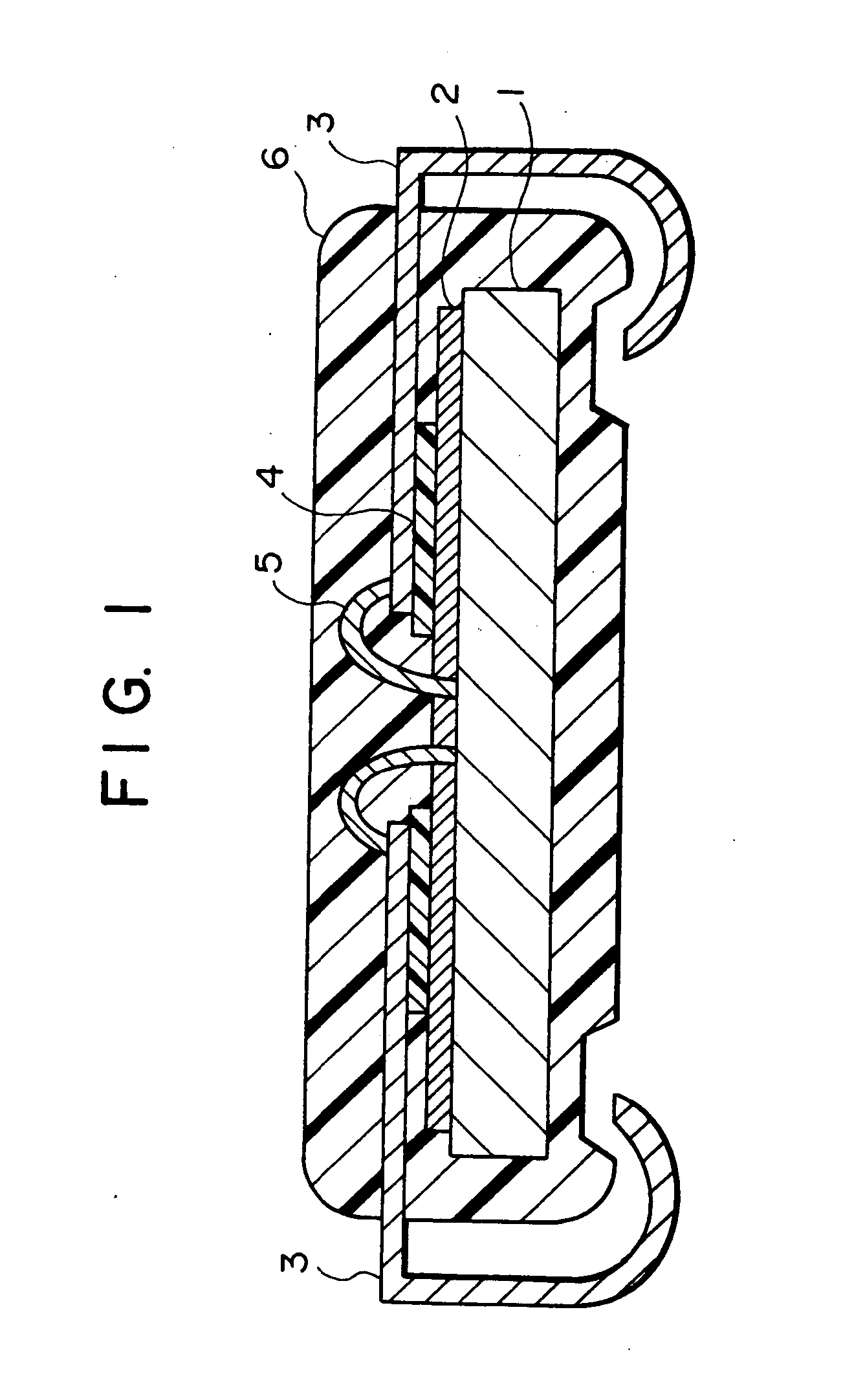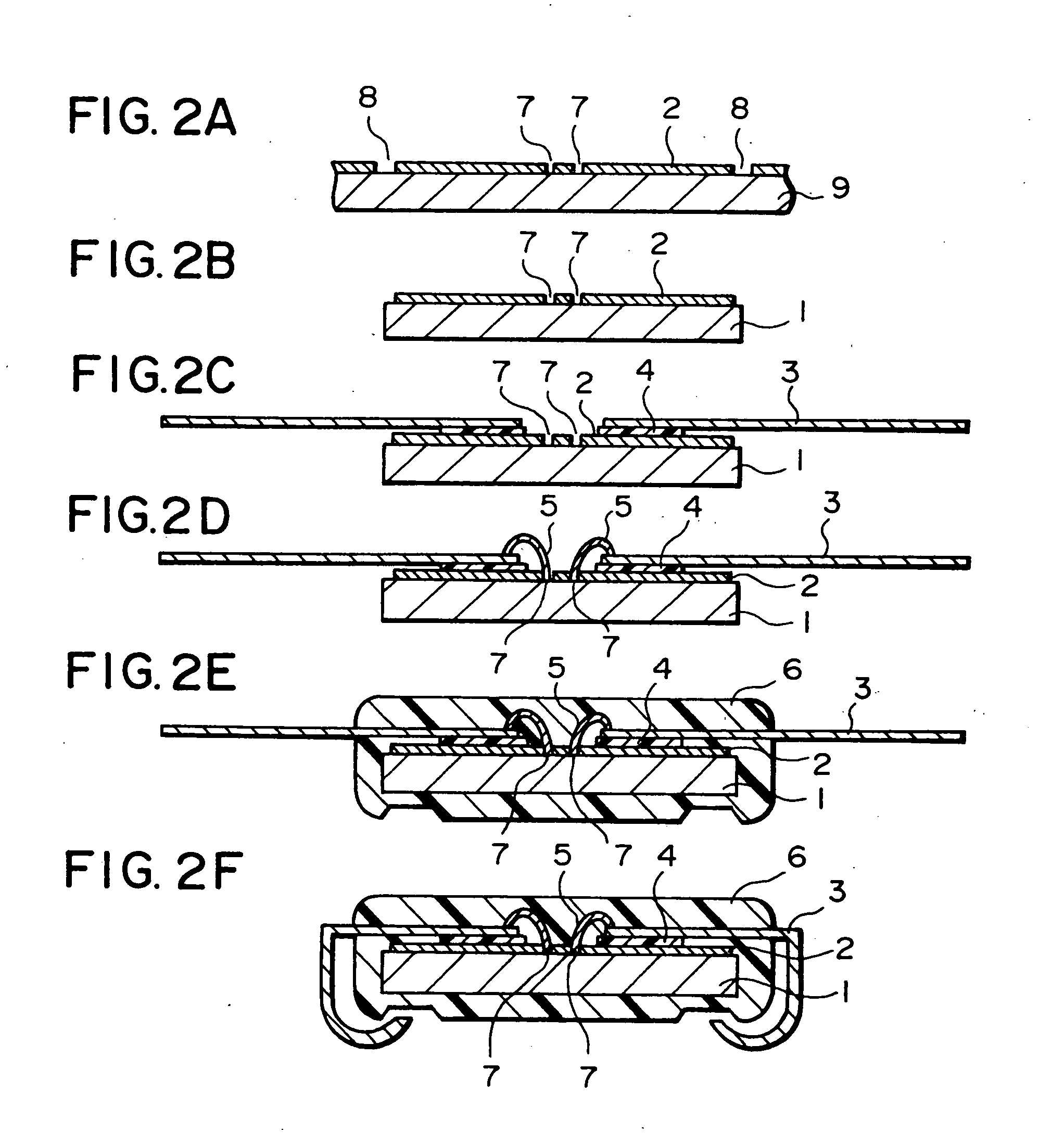Resin-encapsulated semiconductor apparatus and process for its fabrication
a technology of encapsulation and semiconductor devices, applied in the direction of resistors, basic electric elements, solid-state devices, etc., can solve the problems of serious reliability problems, solder reflow resistance problems, etc., and achieve good polarization characteristics and high reliability.
- Summary
- Abstract
- Description
- Claims
- Application Information
AI Technical Summary
Benefits of technology
Problems solved by technology
Method used
Image
Examples
example 1
In a stream of nitrogen, 92.0 g (0.46 mol) of 4,4′-diaminodiphenyl ether and 9.12 g (0.44 mol) of 4-aminophenyl 4-amino-3-carbonamidophenyl ether were dissolved in 1,580.2 g of N-methyl-2-pyrrolidone to prepare an amine solution. Next, keeping the temperature of this solution at about 15° C., a mixture of 54.5 g (0.25 mol) of pyromellitic dianhydride and 80.5 g (0.25 mol) of 3,3′,4,4′-benzophenonetetracarboxylic dianhydride was added while stirring. After their addition was completed, the reaction mixture was further reacted while stirring at about 15° C. for about 5 hours in an atmosphere of nitrogen, to obtain a polyimide precursor composition solution with a viscosity of about 30 poises. The polyimide precursor composition solution thus obtained contains as the polyimide precursor the polyamic acid represented by the following general formula (I).
Here, the polyamide acid of the present Example is a copolymer wherein R1 is
In the formulas (XI) and (XII), the numerals in brac...
example 2
In a stream of nitrogen, 88.0 g (0.44 mol) of 4,4′-diaminodiphenyl ether and 13.68 g (0.06 mol) of 4-aminophenyl 4-amino-3-carbonamidophenyl ether were dissolved in 1,584 g of N-methyl-2-pyrrolidone to prepare an amine solution. Next, keeping the temperature of this solution at about 15° C., a mixture of 54.5 g (0.25 mol) of pyromellitic dianhydride and 80.5 g (0.25 mol) of 3,3′,4,4′-benzophenonetetracarboxylic dianhydride was added while stirring. After their addition was completed, the mixture was further reacted while stirring at about 15° C. for about 5 hours in an atmosphere of nitrogen, to obtain a polyimide precursor composition solution with a viscosity of about 30 poises. The polyimide precursor composition solution thus obtained contains as the polyimide precursor the same polyamic acid copolymer as that of Example 1 except that R2 1s is in a different copolymerization ratio. The R2 in the present Example is
In the formula (XIII), the numeral in brackets indicates the r...
example 3
In a stream of nitrogen, 90.0 g (0.45 mol) of 4,4′-diaminodiphenyl ether and 9.6 g (0.05 mol) of bis(3-aminopropyl)tetramethyldisiloxane were dissolved in 1,584 g of N-methyl-2-pyrrolidone to prepare an amine solution. Next, keeping the temperature of this solution at about 15° C., 147 g (0.5 mol) of 3,3′,4,4′-biphenyltetracarboxylic dianhydride was added while stirring. After its addition was completed, the reaction mixture was further reacted while stirring at about 15° C. for about 5 hours in an atmosphere of nitrogen, to obtain a polyimide precursor composition solution with a viscosity of about 50 poises. The polyimide precursor composition solution thus obtained contains as the polyimide precursor a polyamic acid copolymer comprised of a first repeating unit represented by the following general formula (XIV) and a second repeating unit represented by the following general formula (XV). Here, the proportion of the number of the second repeating unit to the total number of the ...
PUM
| Property | Measurement | Unit |
|---|---|---|
| glass transition temperature | aaaaa | aaaaa |
| temperature | aaaaa | aaaaa |
| temperatures | aaaaa | aaaaa |
Abstract
Description
Claims
Application Information
 Login to View More
Login to View More - R&D
- Intellectual Property
- Life Sciences
- Materials
- Tech Scout
- Unparalleled Data Quality
- Higher Quality Content
- 60% Fewer Hallucinations
Browse by: Latest US Patents, China's latest patents, Technical Efficacy Thesaurus, Application Domain, Technology Topic, Popular Technical Reports.
© 2025 PatSnap. All rights reserved.Legal|Privacy policy|Modern Slavery Act Transparency Statement|Sitemap|About US| Contact US: help@patsnap.com



